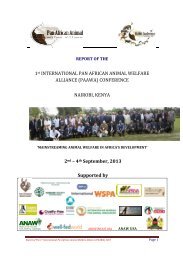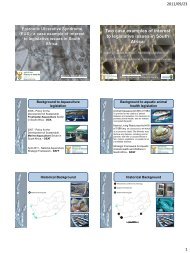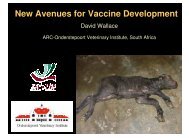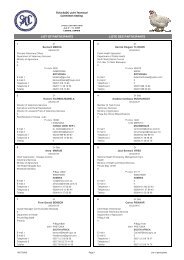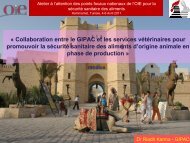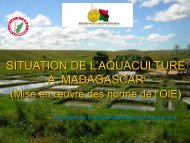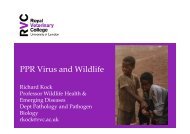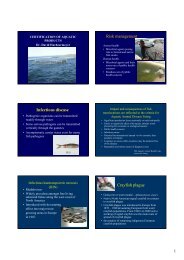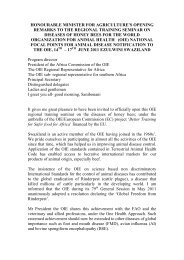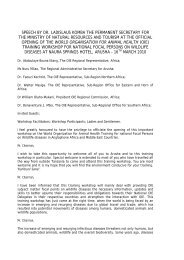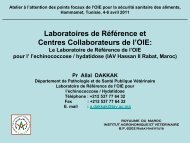Case Study: SPS Issues and Regional Trade in ... - OIE Africa
Case Study: SPS Issues and Regional Trade in ... - OIE Africa
Case Study: SPS Issues and Regional Trade in ... - OIE Africa
Create successful ePaper yourself
Turn your PDF publications into a flip-book with our unique Google optimized e-Paper software.
Ports of EntryThe veter<strong>in</strong>ary import permit <strong>and</strong> the veter<strong>in</strong>ary health certificate must be presented to therelevant authorities at the port of entry. Only orig<strong>in</strong>al documents will be accepted. Meatmust be <strong>in</strong>spected at one of follow<strong>in</strong>g <strong>in</strong>spection sites stipulated on the import permit.Importation from countries not export<strong>in</strong>g to South <strong>Africa</strong> at presentAn application to import meat from countries not export<strong>in</strong>g to South <strong>Africa</strong> at present (or toimport a particular product for the first time from a country export<strong>in</strong>g other animal productsto South <strong>Africa</strong>) is evaluated <strong>in</strong> terms of the relevant legislation, <strong>in</strong>ternational st<strong>and</strong>ards<strong>and</strong> other requirements. South <strong>Africa</strong> is an active member of an <strong>in</strong>ternational network ofveter<strong>in</strong>ary adm<strong>in</strong>istrations. Through these <strong>in</strong>ternational contacts the South <strong>Africa</strong>nVeter<strong>in</strong>ary Services receive regular reports on the disease status of other countries.Disease reports are received from the <strong>OIE</strong> <strong>and</strong> by direct contact with the veter<strong>in</strong>aryadm<strong>in</strong>istrations <strong>in</strong> the export<strong>in</strong>g countries.<strong>Trade</strong> is based on a series of requirements, which the import<strong>in</strong>g country considersappropriate to prevent the entry of diseases. The regulat<strong>in</strong>g authority <strong>in</strong> the import<strong>in</strong>gcountry always requires someone <strong>in</strong>dependent of commercial <strong>in</strong>volvement <strong>in</strong> the export<strong>in</strong>gcountry to act as its agent to ensure that its import requirements are appropriate for thetrade <strong>and</strong> that they are complied with when an export takes place. The Directorate ofVeter<strong>in</strong>ary Services specifies that this must be its equivalent government agency. In somecircumstances it may be considered sufficient for the process to be audited by thegovernment body. The draft conditions of trade are drawn up by the Directorate Veter<strong>in</strong>aryServices <strong>and</strong> represent the Directorate‟s perceptions of the export<strong>in</strong>g country's animalhealth status. The conditions usually reflect the concerns of the South <strong>Africa</strong>n agricultural<strong>in</strong>dustries <strong>and</strong> own livestock disease status. Because the <strong>in</strong>dustries perceptions are notalways well-founded, considerable negotiation often takes place to try to reduce therequirements to the lowest level compatible with the ma<strong>in</strong>tenance of adequate agriculturalsecurity.The animal disease situation <strong>in</strong> a country is first evaluated us<strong>in</strong>g <strong>OIE</strong> reports <strong>and</strong> other<strong>in</strong>formation available <strong>in</strong>ternationally. Depend<strong>in</strong>g on the outcome it is decided whetherfurther consideration should be given to the importation of a product from a certa<strong>in</strong>country. If the outcome is favorable the next step is usually to send a questionnaire to theveter<strong>in</strong>ary adm<strong>in</strong>istration. After the response to the questionnaire has been received <strong>and</strong>evaluated, the South <strong>Africa</strong>n Veter<strong>in</strong>ary Services decide whether an <strong>in</strong>spection visit toevaluate the animal disease situation, veter<strong>in</strong>ary control <strong>and</strong> surveillance programs shouldbe planned <strong>and</strong> budgeted for. The <strong>in</strong>spection of establishments can be done dur<strong>in</strong>g thesame visit, but will usually only be considered if the animal health situation appears to befavorable. Inspection visits are planned <strong>and</strong> budgeted for, each f<strong>in</strong>ancial year (start<strong>in</strong>g 1April). It is usually very difficult to deviate from this schedule. Before plann<strong>in</strong>g an <strong>in</strong>spectionvisit our Directorate requires the follow<strong>in</strong>g from the Chief Veter<strong>in</strong>ary Officer of theprospective export<strong>in</strong>g country:1 An official <strong>in</strong>vitation2 A day-by-day it<strong>in</strong>erary.3 Confirmation that the establishments (abattoirs, cutt<strong>in</strong>g plants, etc) have been<strong>in</strong>spected <strong>and</strong>, <strong>in</strong> their op<strong>in</strong>ion, could comply with our requirements [Meat SafetyAct, 2000 (Act 40 of 2000) <strong>and</strong> the regulations promulgated there-under]A major part of the risk analysis aims to confirm the reliability of statements made by theveter<strong>in</strong>ary authority <strong>in</strong> the export<strong>in</strong>g country <strong>and</strong> by the <strong>in</strong>dustry organizations <strong>in</strong> that33



